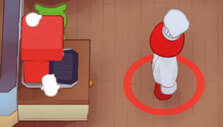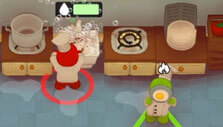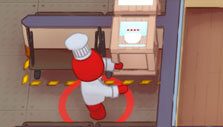PlateUp!
 by Aethyna
Aug 22, 2022 |
1
Votes |
88
Played |
0
Reviews
by Aethyna
Aug 22, 2022 |
1
Votes |
88
Played |
0
Reviews
 10
rate
Featuring incredible depth, variety and strategy, PlateUp! is an Overcooked-like time management-based co-op game, where you and up to 3 of your friends need to prepare, cook and serve food to your customers as timely as you can, but with a nice blend of roguelite and a dash of automation that’s unlocked as you level up your chef.
Play Now
Similar Games
Played
10
rate
Featuring incredible depth, variety and strategy, PlateUp! is an Overcooked-like time management-based co-op game, where you and up to 3 of your friends need to prepare, cook and serve food to your customers as timely as you can, but with a nice blend of roguelite and a dash of automation that’s unlocked as you level up your chef.
Play Now
Similar Games
Played
People Also Played







Summary
PlateUp! is an Overcooked-like time management-based co-op game, where you and up to 3 of your friends need to prepare, cook and serve food to your customers as timely as you can, but with a nice blend of roguelite and a dash of automation that’s unlocked as you level up your chef. Featuring incredible depth and strategy, the game also has a nice variety of floorplans and locations, some of which makes the act of cooking and serving your customers slightly easier; plenty of recipes, some more complicated than the next, but yet more lucrative; as well as upgradeable kitchenware and various special one-use kitchen appliances that you can earn as bonuses from previous runs, making future runs a bit easier.
As you progress, the game ramps up the difficulty with Active cards, adding new side dishes or desserts, increasing foot traffic during certain times of day, or hiding previously visible indicators on, say, your customers (patience meter) or the hob (cooking indicators), making it very difficult to get to the end game – getting a 5-star rating for your restaurant. Will you be able to make it?
Gameplay
After a simple tutorial, where you’ll learn the basics of the game, you’ll then be unceremoniously headquarters of sorts. Here, you’ll need choose a floorplan and a menu (the recipe) for your restaurant. You won’t start with a whole lot of options but as you advance, you’ll unlock new floorplans, new locations and new recipes which will give you more options to choose from.
At the HQ, there’s also a practice kitchen, allowing you go through the motions of preparing the recipe you’ve chosen just so you’ll know what to do when your run starts. There’s also a warehouse-like room where special kitchen appliances, such as the dishwasher, that are earned as reward after a run are stored. You can bring up to 2 of these appliances with you in a run by simply placing them on the trolleys at the loading bay.
As mentioned, PlateUp! is similar to Overcooked in the sense that they are both co-op-oriented time management games that has a fun restaurant setting. You’ll need to prepare the ingredients, cook them, and serve the food in a timely manner. There are the occasional fires to extinguish and burnt food to dump, but this is where the similarities end.
There’s no option for you to “throw” items between players or even to the counter to save time. Besides the messes that can appear (and accumulate) on the floor which makes walking through them like trying to wade through a chest-high swamp, there aren’t any wacky obstacles that can knock you off platforms, teleport you to a higher floor, or block paths to important appliances.
Plus, unlike in Overcooked, you actually have to take orders and serve your customers at their tables much like in Diner Dash and not just deliver a dish to the conveyor belt. But in contrast to Diner Dash, the customers at the same table in this game expect to get their food at almost the same time. This is why it’s not possible to serve one dish and hope it’ll increase your customers’ patience enough to buy you more time to prepare the rest of the food they ordered.
Unlike in Diner Dash as well, you can’t drag and drop customers to assign them to specific tables. Instead, your customers will choose a table that fit their needs. At times, you’ll have a full house while your newly-arrived customers start queueing up outside. This is all good when it’s bright and sunny outside, but it’ll work against you if it’s nighttime or if it’s raining.
The game also provides you with a whole lot more flexibility in terms of how to design your restaurant, namely by placing/moving décor which typically increases customer patience as well as the tables and chairs, since your sitting customers can, sometimes, become an obstacle and block your path. Adding more décor will also grant you bonuses and the types of décor you get depends on which “style” you opted for, whether Charming, Affordable, Exclusive, or Formal. After each “day”, you’ll get a bunch of blueprints which will allow you to purchase certain kitchen items.
How many blueprints you can buy, from the 5-6 that you get, depends entirely on how much money you have and how much space you have left in your restaurant. Of course, you’ll also need to consider if that blueprint can actually help in your day-to-day and not just end up being an obstacle that you’ll have to navigate around. The types of blueprints you get depends on which point on the timeline, shown at the top of the screen during the planning mode, you are at. Don’t see a blueprint you want? You can try rerolling your blueprints by spending a little cash.
Some of these blueprints are upgradeable as well (note the green “plus” icon), but you can’t upgrade them after they are purchased and placed in your restaurant. Instead, what you need to do is to place the blueprint in the blueprint cabinet that you can right from the get-go and place a research table right next to it. Then, during a “day”, you’ll need to take some time off your hectic schedule to research the upgrade.
It took me a while to realize this unfortunately, which kind of ruins my first run, but trust me when I say that some upgraded blueprints can be incredibly useful, like the upgraded mop when it comes to cleaning messes or an upgraded counter, a.k.a. a workstation, which makes cutting up stuff a lot faster.
Once you get to the late game and have unlocked a lot of new items, the game then throws in automation to spice things up even further with machines like the auto-plater, auto-slicer, grabbers or better yet, their upgraded version, the smart grabbers, and others. If you place everything correctly, you should be able to automate the food preparing and maybe even the main cooking process, allowing you and your friends to focus on customer service and preparing desserts, which couldn’t be automated here.
Automation is something that I still struggle with in this game namely because I still couldn’t figure out how to manually rotate stuff and how to place, for instance, the auto-plater and the counter so that it can auto-plate the food I place on the counter. Maybe it only works for conveyor belts? Who knows? Anyway, if you want to test-run your automated processes before actually starting a day, the game offers a Practice Mode that you can hop into before starting a new day. Note that automation is very important if you’re playing the game alone since you don’t have the extra hands.
I should also point out that although you can easily move stuff around in your restaurant in between days, there’s no option for you to sell off kitchenware that you no longer need, though you can still remove, say… an extra counter or sink, by simply dumping it outside your restaurant. You just don’t get any compensation for doing so.
Interestingly enough, PlateUp! is also a roguelite and hence, permadeath is a thing here. It is triggered whenever a customer leaves in anger and frustration, which results in the sudden closure of your restaurant. It’s very drastic to be honest, but it does seem like reputation is everything here in PlateUp!
Once you hit a milestone while on a run and added a rating to your restaurant, the game will have you take on an Active card out of the two choices given. These cards often are “boons”, meaning that they will increase the difficulty of the game, sometimes quite drastically. Some of these cards will add a side dish or a dessert that your customers can now order. Side dishes will usually take some time to prepare while desserts will make customers stay longer at their tables, causing a (hazardous) build-up of new customers outside the door.
Some of the cards will hide crucial information or indicators such as a customers’ patience level or the cooking progress of your food, while others may increase or decrease your customer group size or number at certain times of the day. All cards will grant you some extra experience points which contribute to the overall –meta- progression, which will level your chef up and unlocks new gameplay features like new locations, floorplans or recipes. Thankfully, some cards, mostly those that introduce a new side dish, menu item or dessert, will decrease the number of expected customers by a nice percentage.
Now, in this game, the longer you play, the more expected customers will come to your restaurant. The group sizes may increase as well. Due to having to serve an entire table’s orders almost simultaneously, serving larger groups is definitely more challenging here because you have very little time window for serving. The rapidly-moving timer starts immediately with the first dish served and that you’re expected to continuously serve the rest of the table’s orders one after another without pausing for anything else, including cooking. So, here’s a tip – make sure you have all the dishes ready to go before serving. You can thank me later for that!
Personally, I think the roguelite aspect actually made the game – and I know this is sacrilegious for some – even better the Overcooked. If you fail in this game, you can still pick yourself up, get a new kitchen appliance to help out in the next run, and not just throw yourself at the level until you manage to clear it with at least one star… yes, I’m talking to you Surf n’ Turf level 3-2 with your stupid chokepoint and mind-reading fires!
As much fun as I had in PlateUp, I do have a little bone to pick with the game. Although each day is fairly short and sweet, an entire run may last between 1 to 2 hours, depending on how far you managed to go. It would be great if there’s an option to save the game during a run, just so I could continue it at a later date, once whatever that needs doing urgently gets resolved. Granted that you can technically do as I did and simply pause the game and leave it running on the PC for however long you need, this option may not be feasible for some and is very energy wasting, despite being able to turn-off the monitor to save some precious few joules.
Community
PlateUp! is obviously designed with co-op in mind. Although it can entirely be played in single-player mode, the game is much more fun and perhaps easier with friends… up to 3 of them. If played in co-op, each player, up to a total of 4, can be assigned a specific role, whether to wash dishes or clean the floors, but if you’re playing it in single-player, you’ll then be expected to wear many hats, including as the janitor, the dishwasher, the chef and the waiter.
The game can be played via split screen locally, online co-op, or through Steam’s remote play. However, I’d like to mention that for remote play, latency is still a major issue and the host needs to have stable and high-speed internet to be able to properly stream the game to a friend to play with. Naturally, you’ll need a lot more resources to stream the game to multiple friends.
Need some friends to play with? Well, you can find some in the discussion section of the Steam page or you could drop by its Discord and team up with some new friends.
Graphics/ Sound
The graphics here look good for a restaurant game. It’s fairly minimalistic in the sense that there isn’t much detail for certain stuff like the mess that people make – it’s just shown as a liquid spill on the floor, or that you don’t get an option to “dress up” your customer’s tables. In terms of sound, the game has several soundtracks that are similar to elevator music in some way. They are all pleasant to listen to while playing and they do not intrude on the gameplay itself. There’s also ambiance, such as the sound of rain during rainy days, and, of course, sound effects.
Conclusion
I can literally count in one hand how many other co-op restaurant management games that can measure up, or even stand on the same footing, as the highly popular Overcooked series, and I’m glad to say that PlateUp! is undoubtedly one of those few rare games. In addition to letting you customize your restaurant’s layout, the roguelite element actually made the gameplay loop even better, offering players a completely new experience on every run, be it through a different blend of active cards, purchased blueprints or upgraded blueprints. The game provides a single player experience as well. Needless to say, PlateUp! is definitely worth its asking price, and more!
So, if you absolutely love Overcooked or other similar games, you mustn’t miss out on PlateUp! Grab your group of friends and start cooking!
PlateUp! Blog
New Game Added: PlateUp!
 by Aethyna
Aug 22, 2022
by Aethyna
Aug 22, 2022
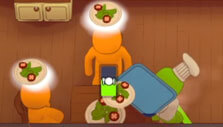
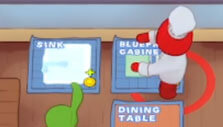
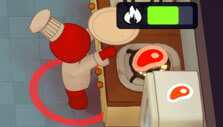 Read More
Read More
Featured Games
 Realm of Warriors
Assemble a party of the strongest heroes to take on both the rebel forces and the corrupting influence of the Dragon Demon in this Chinese-themed browser MMORPG, Realm of Warriors!
Realm of Warriors
Assemble a party of the strongest heroes to take on both the rebel forces and the corrupting influence of the Dragon Demon in this Chinese-themed browser MMORPG, Realm of Warriors!
 RAID: Shadow Legends
Recruit the best to join your team and take on Siroth, the Lord of Darkness himself!
RAID: Shadow Legends
Recruit the best to join your team and take on Siroth, the Lord of Darkness himself!
 Hustle Castle
Save the king and his daughter from the abyssal lord as he threatens to destroy your kingdom and marry your bride to be in this fun mmo simulation game.
Hustle Castle
Save the king and his daughter from the abyssal lord as he threatens to destroy your kingdom and marry your bride to be in this fun mmo simulation game.
 Dark Genesis
Play Dark Genesis and save the world from destruction with your allies.
Dark Genesis
Play Dark Genesis and save the world from destruction with your allies.
 War Robots
Head into the cockpit of a mech and decimate opponents in War Robots.
War Robots
Head into the cockpit of a mech and decimate opponents in War Robots.
 Blade of Kings
Blade of Kings is an idle RPG by Esprit Games. You’ll take a role of a warrior, defending the land from hordes of monsters and attempting to rise in rank in the kingdom. Take part in action-packed idle battles, use a variety of skills, raise pets, and achieve victory.
Blade of Kings
Blade of Kings is an idle RPG by Esprit Games. You’ll take a role of a warrior, defending the land from hordes of monsters and attempting to rise in rank in the kingdom. Take part in action-packed idle battles, use a variety of skills, raise pets, and achieve victory.






